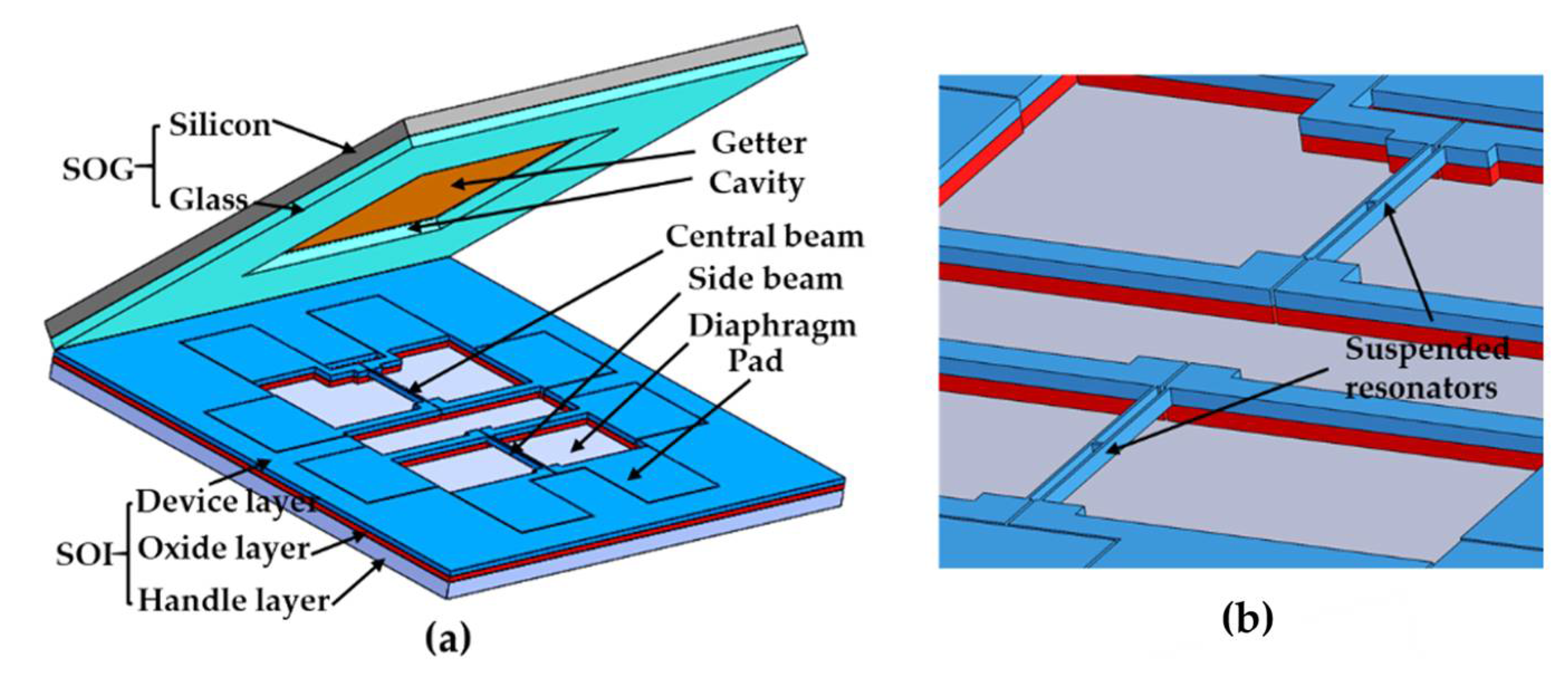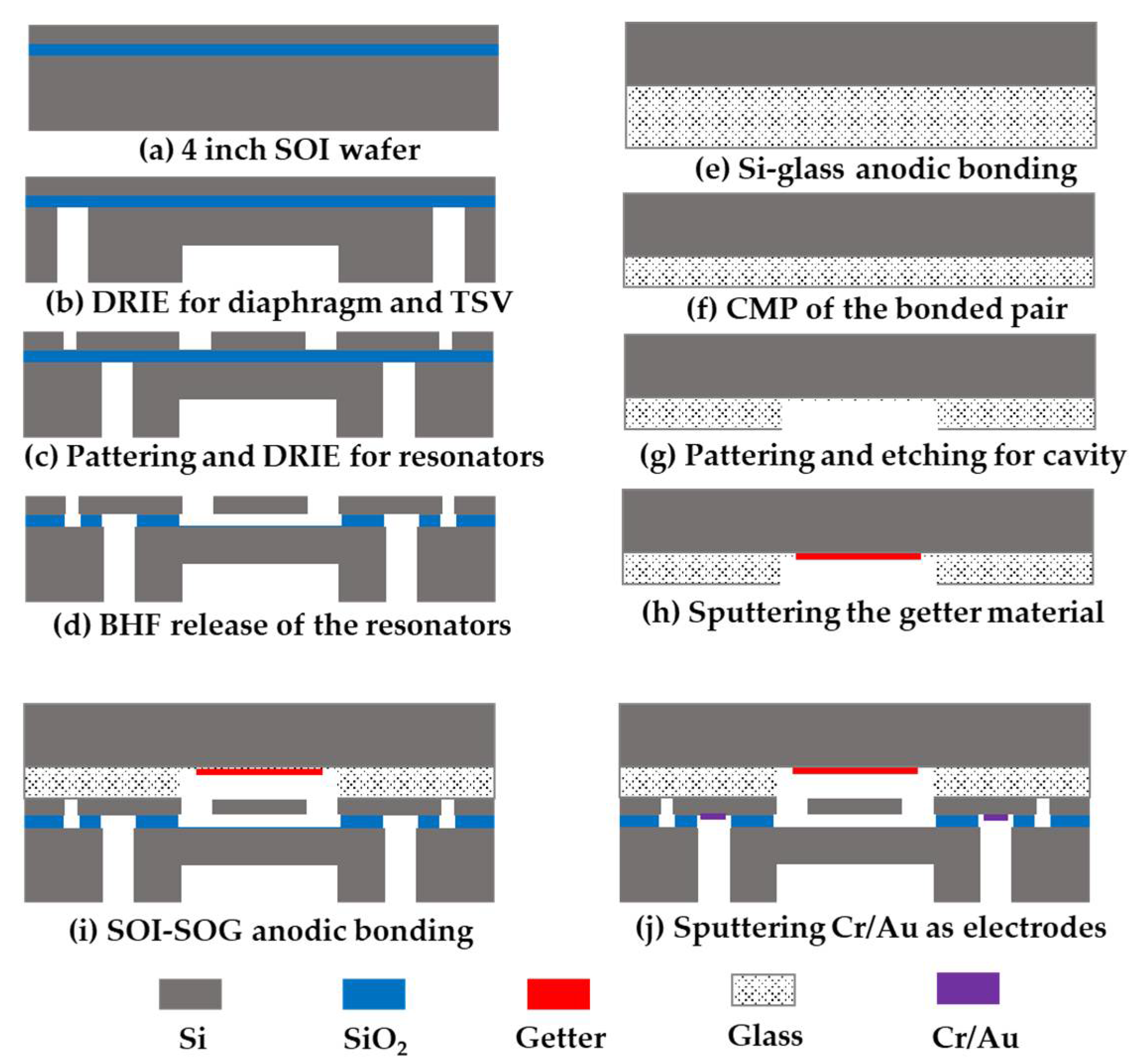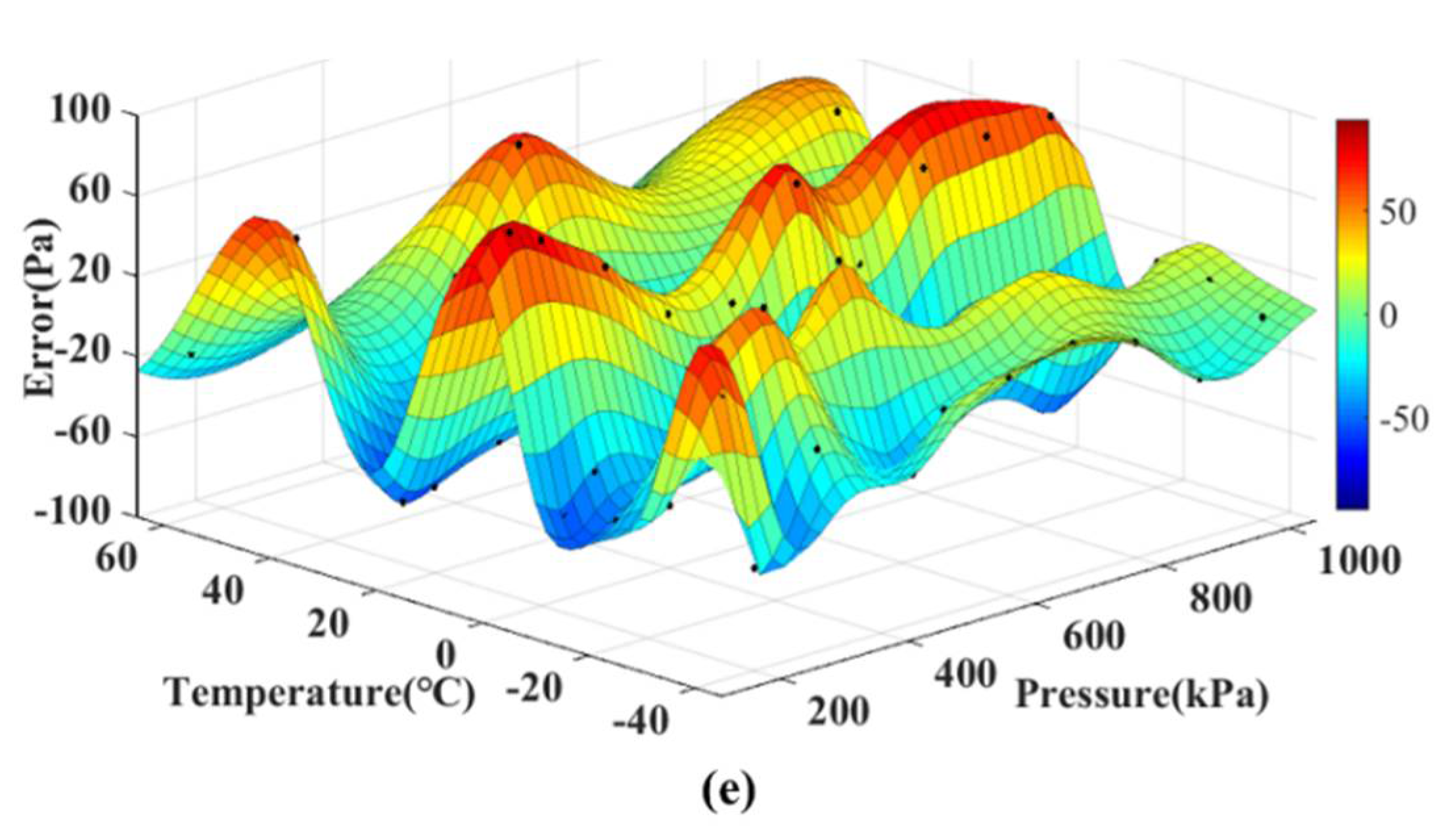A Temperature-Insensitive Resonant Pressure Micro Sensor Based on Silicon-on-Glass Vacuum Packaging
Abstract
1. Introduction
2. Methodology
2.1. Working Principle:
2.2. Thermomechanical Mechanism and Simulations:
3. Fabrication
4. Characterizations
5. Conclusions
Author Contributions
Funding
Conflicts of Interest
References
- Ikeda, K.; Kuwayama, H.; Kobayashi, T.; Watanabe, T.; Nishikawa, T.; Yoshida, T.; Harada, K. Silicon pressure sensor integrates resonant strain gauge on diaphragm. Sens. Actuators A Phys. 1990, 21, 146–150. [Google Scholar] [CrossRef]
- Welham, C.J.; Greenwood, J.; Bertioli, M.M. A high accuracy resonant pressure sensor by fusion bonding and trench etching. Sens. Actuators A Phys. 1999, 76, 298–304. [Google Scholar] [CrossRef]
- Chen, D.; Li, Y.; Liu, M.; Wang, J. Design and experiment of a laterally driven micromachined resonant pressure sensor for barometers. Procedia Eng. 2010, 5, 1490–1493. [Google Scholar] [CrossRef]
- Corman, T.; Enoksson, P.; Stemme, G. Low-pressure-encapsulated resonant structures with integrated electrodes for electrostatic excitation and capacitive detection. Sens. Actuators A Phys. 1998, 66, 160–166. [Google Scholar] [CrossRef]
- Melamud, R.; Hopcroft, M.; Jha, C.; Kim, B.; Chandorkar, S.; Candler, R.; Kenny, T.W. Effects of stress on the temperature coefficient of frequency in double clamped resonators. In Proceedings of the 13th International Conference on Solid-State Sensors, Actuators and Microsystems, 2005 (TRANSDUCERS '05), Seoul, Korea, 5–9 June 2005; pp. 392–395. [Google Scholar]
- Hao, Y.; Yuan, W.; Xie, J.; Shen, Q.; Chang, H. Design and verification of a structure for isolating packaging stress in SOI MEMS devices. IEEE Sens. J. 2016, 17, 1246–1254. [Google Scholar] [CrossRef]
- Li, A.; Zhang, C.; Wang, H.; He, Y.; Sun, D.; Wang, L.; Du, X.; Gu, D. Design of temperature-immunization system packaging for the resonant pressure sensor. Mod. Phys. Lett. B 2017, 31, 1750085. [Google Scholar] [CrossRef]
- Rogers, T.; Kowal, J. Selection of glass, anodic bonding conditions and material compatibility for silicon-glass capacitive sensors. Sens. Actuators A Phys. 1995, 46, 113–120. [Google Scholar] [CrossRef]
- Lee, J.S.; Faheem, F.; Kim, J.F.; Jung, J.D. MEMS packaging technology using a cavity structure for mass production. In Proceedings of the International Conference on Electronic Materials & Packaging, Daejeon, Korea, 19–22 November 2007. [Google Scholar]
- Offereins, H.; Sandmaier, H.; Folkmer, B.; Steger, U.; Lang, W. Stress free assembly technique for a silicon based pressure sensor. In Proceedings of the 1991 International Conference on Solid-State Sensors and Actuators (Transducer'91), San Francisco, CA, USA, 24–27 June1991; pp. 986–989. [Google Scholar]
- Marinis, T.F.; Soucy, J.W.; Hanson, D.S. Isolation of MEMS devices from package stresses by use of compliant metal interposers. In Proceedings of the 56th Electronic Components and Technology Conference 2006, San Diego, CA, USA, 30 May–2 June 2006. [Google Scholar]
- Li, Y.; Chen, D.; Wang, J. Vacuum adhesive bonding and stress isolation for MEMS resonant pressure sensor package. Mater. Sci. Forum 2011, 694, 896–900. [Google Scholar] [CrossRef]
- Dinh, T.; Phan, H.P.; Kashaninejad, N.; Nguyen, T.K.; Dao, D.V.; Nguyen, N.T. An on-chip SiC MEMS device with integrated heating, sensing, and microfluidic cooling systems. Adv. Mater. Interfaces 2018, 5, 1800764. [Google Scholar] [CrossRef]
- Dinh, T.; Phan, H.-P.; Nguyen, T.-K.; Balakrishnan, V.; Cheng, H.-H.; Hold, L.; Lacopi, A.; Nguyen, N.-T.; Dao, D.V. Unintentionally doped epitaxial 3C-SiC (111) nanothin film as material for highly sensitive thermal sensors at high temperatures. IEEE Electron. Device Lett. 2018, 39, 580–583. [Google Scholar] [CrossRef]
- Phan, H.-P.; Cheng, H.-H.; Dinh, T.; Wood, B.; Nguyen, T.-K.; Mu, F.; Kamble, H.; Vadivelu, R.; Walker, G.; Hold, L. Single-crystalline 3C-SiC anodically bonded onto glass: An excellent platform for high-temperature electronics and bioapplications. ACS Appl. Mater. Interfaces 2017, 9, 27365–27371. [Google Scholar] [CrossRef] [PubMed]
- Senturia, S.D. Microsystem Design; Springer Science & Business Media: Berlin, Germany, 2007. [Google Scholar]
- Xie, B.; Xing, Y.; Wang, Y.; Chen, D.; Wang, J. Vacuum-packaged resonant pressure sensor with dual resonators for high sensitivity and linearity. Procedia Eng. 2015, 120, 194–199. [Google Scholar] [CrossRef]
- Li, Y.; Wang, J.; Luo, Z.; Chen, D.; Chen, J. A resonant pressure microsensor capable of self-temperature compensation. Sensors 2015, 15, 10048–10058. [Google Scholar] [CrossRef] [PubMed]









| Items | Silicon | BF33 | |
|---|---|---|---|
| Young’s modulus (GPa) | 165 | 64 | |
| Density (g/cm3) | 2.33 | 2.23 | |
| Poisson’s ratio | 0.28 | 0.2 | |
| CTE (ppm/°C) | 20 °C | 2.46 | 3.25 |
| 250 °C | 3.61 | 3.25 | |
| 500 °C | 4.15 | 3.5 |
© 2019 by the authors. Licensee MDPI, Basel, Switzerland. This article is an open access article distributed under the terms and conditions of the Creative Commons Attribution (CC BY) license (http://creativecommons.org/licenses/by/4.0/).
Share and Cite
Yan, P.; Lu, Y.; Xiang, C.; Wang, J.; Chen, D.; Chen, J. A Temperature-Insensitive Resonant Pressure Micro Sensor Based on Silicon-on-Glass Vacuum Packaging. Sensors 2019, 19, 3866. https://doi.org/10.3390/s19183866
Yan P, Lu Y, Xiang C, Wang J, Chen D, Chen J. A Temperature-Insensitive Resonant Pressure Micro Sensor Based on Silicon-on-Glass Vacuum Packaging. Sensors. 2019; 19(18):3866. https://doi.org/10.3390/s19183866
Chicago/Turabian StyleYan, Pengcheng, Yulan Lu, Chao Xiang, Junbo Wang, Deyong Chen, and Jian Chen. 2019. "A Temperature-Insensitive Resonant Pressure Micro Sensor Based on Silicon-on-Glass Vacuum Packaging" Sensors 19, no. 18: 3866. https://doi.org/10.3390/s19183866
APA StyleYan, P., Lu, Y., Xiang, C., Wang, J., Chen, D., & Chen, J. (2019). A Temperature-Insensitive Resonant Pressure Micro Sensor Based on Silicon-on-Glass Vacuum Packaging. Sensors, 19(18), 3866. https://doi.org/10.3390/s19183866







